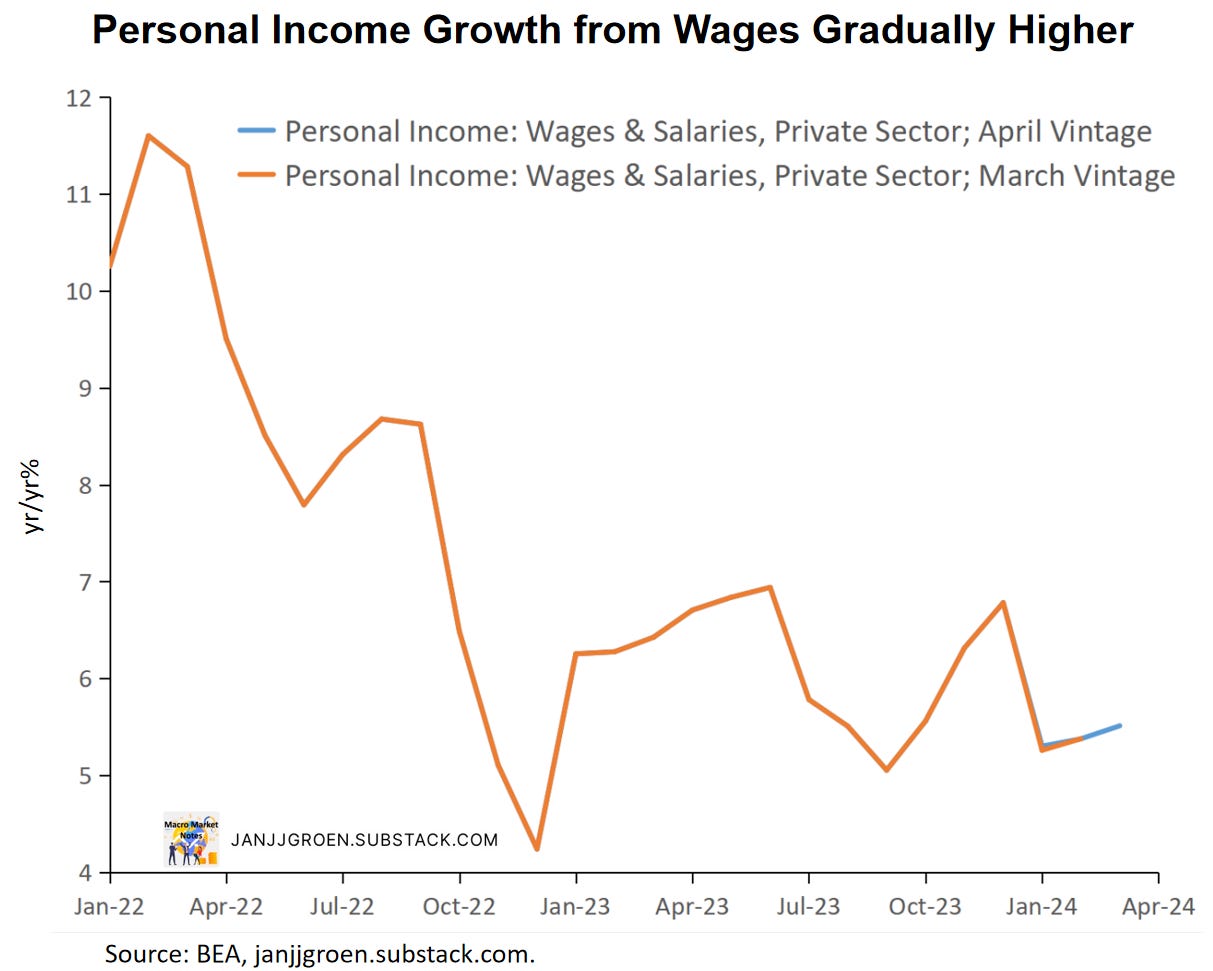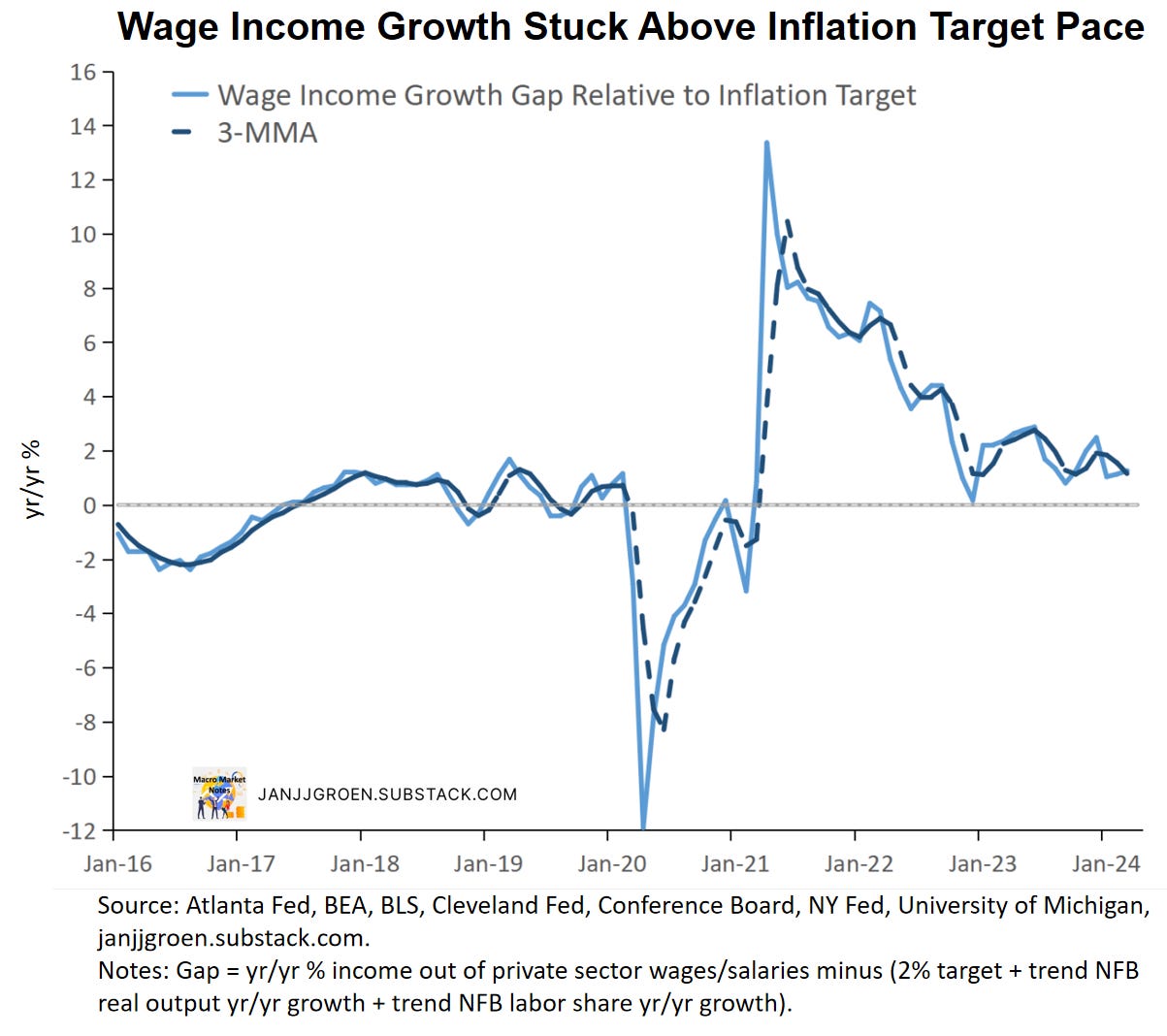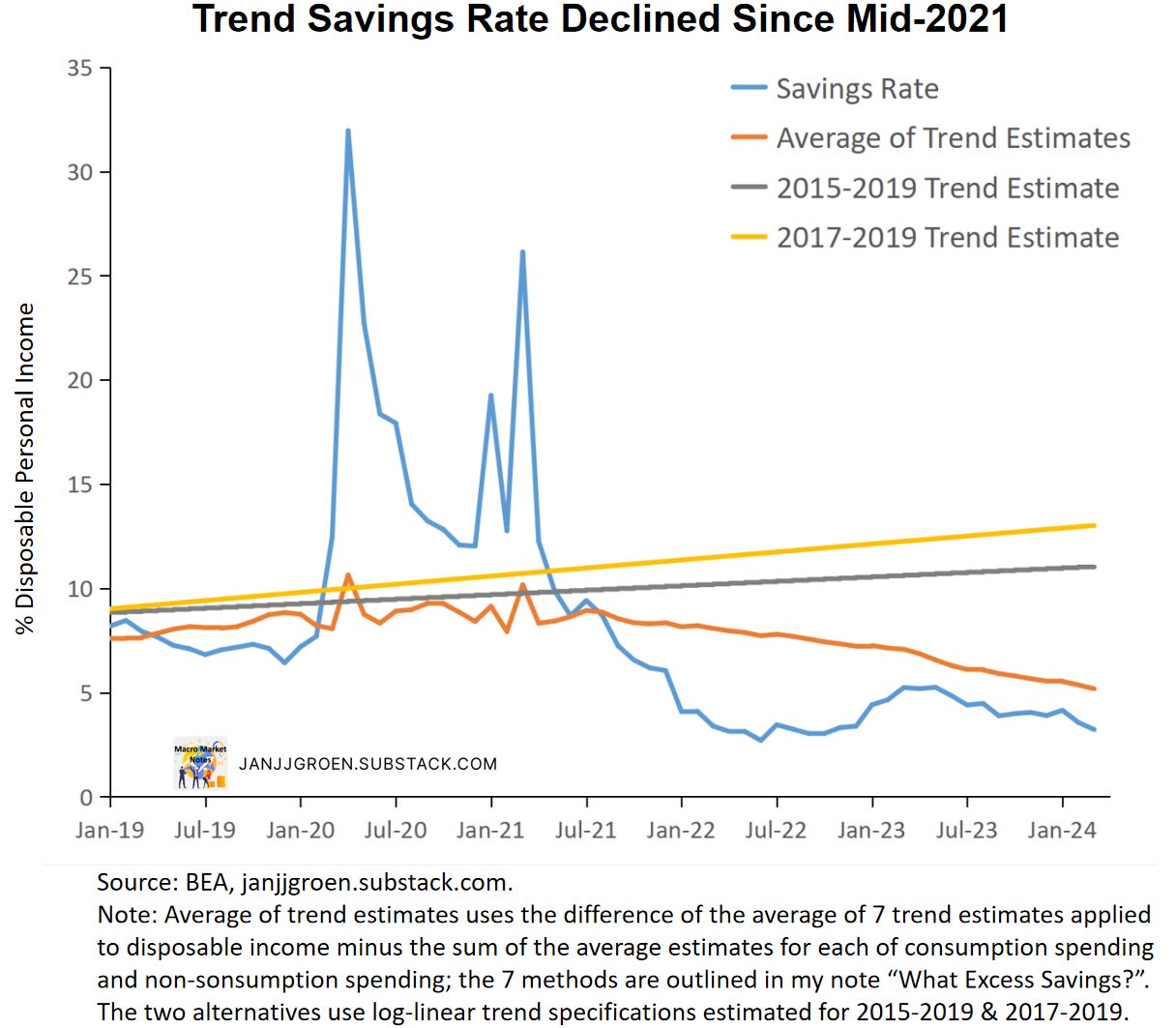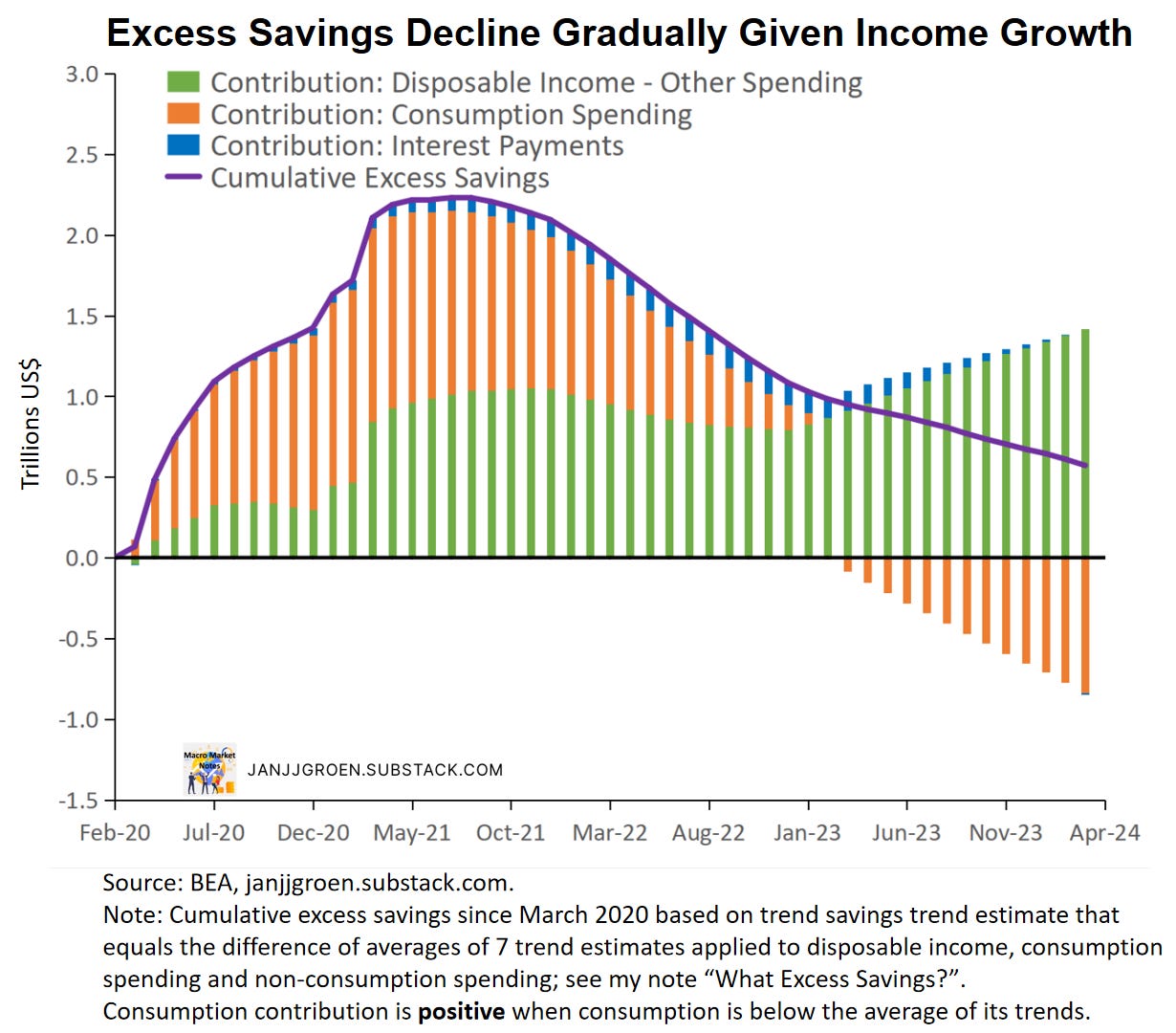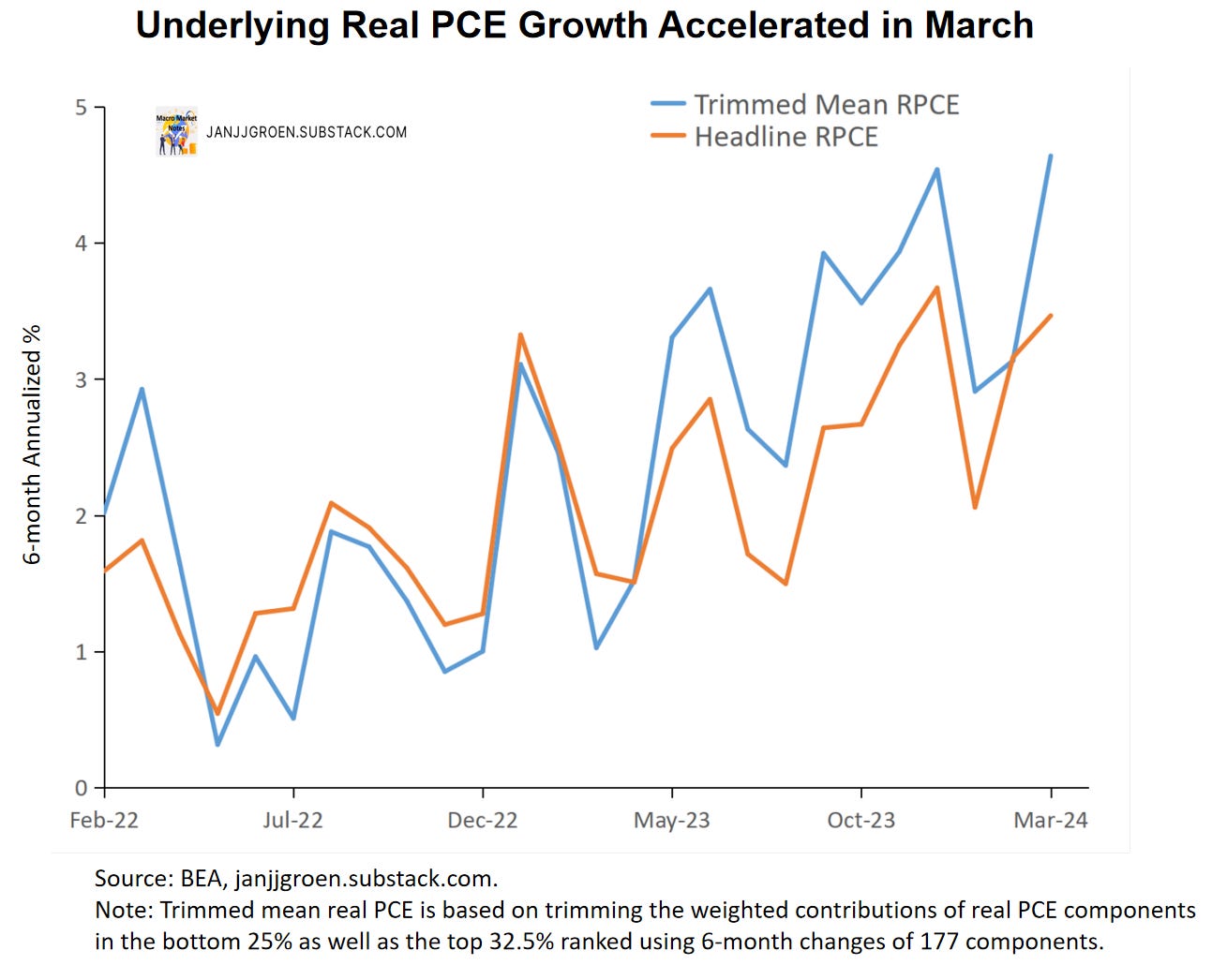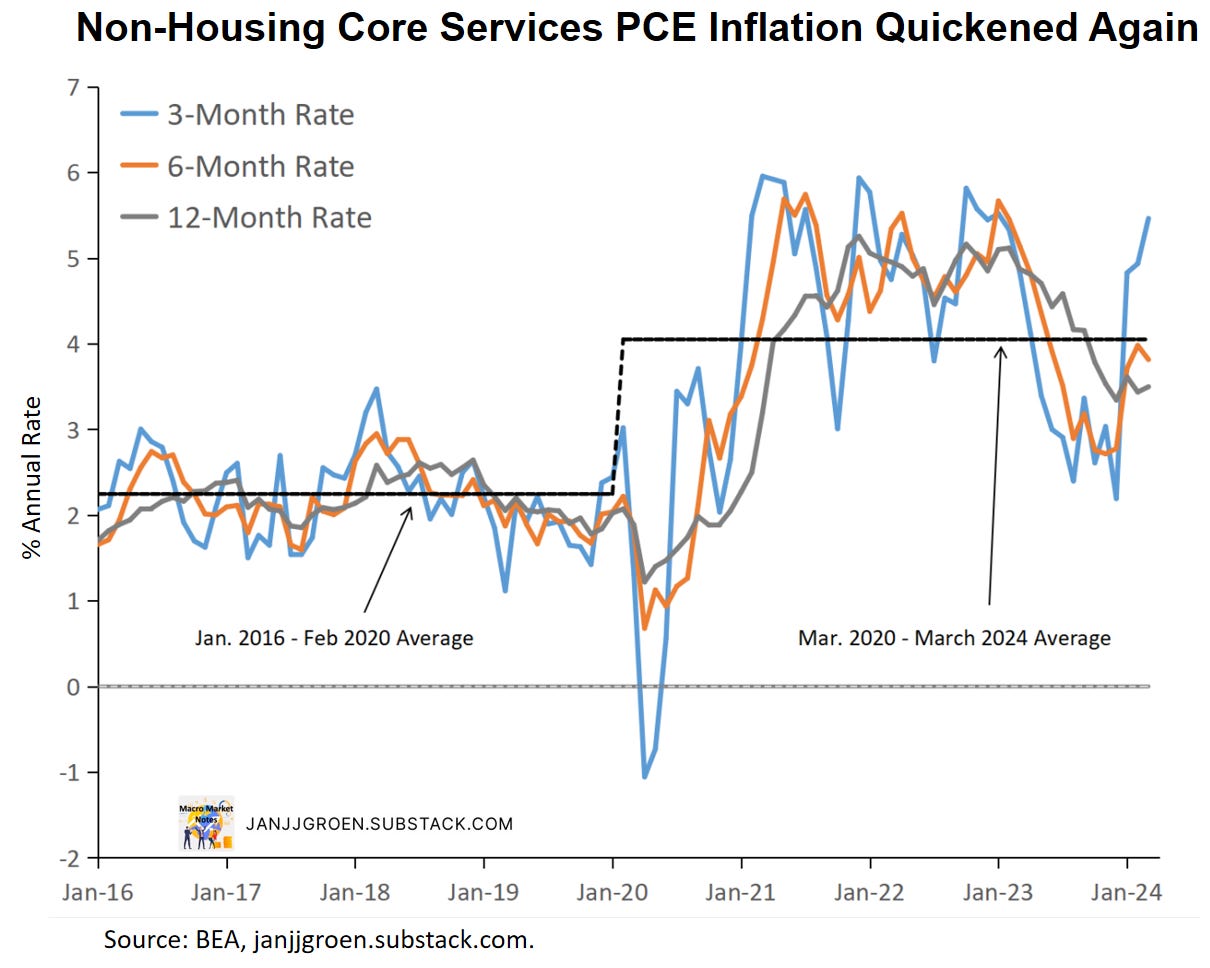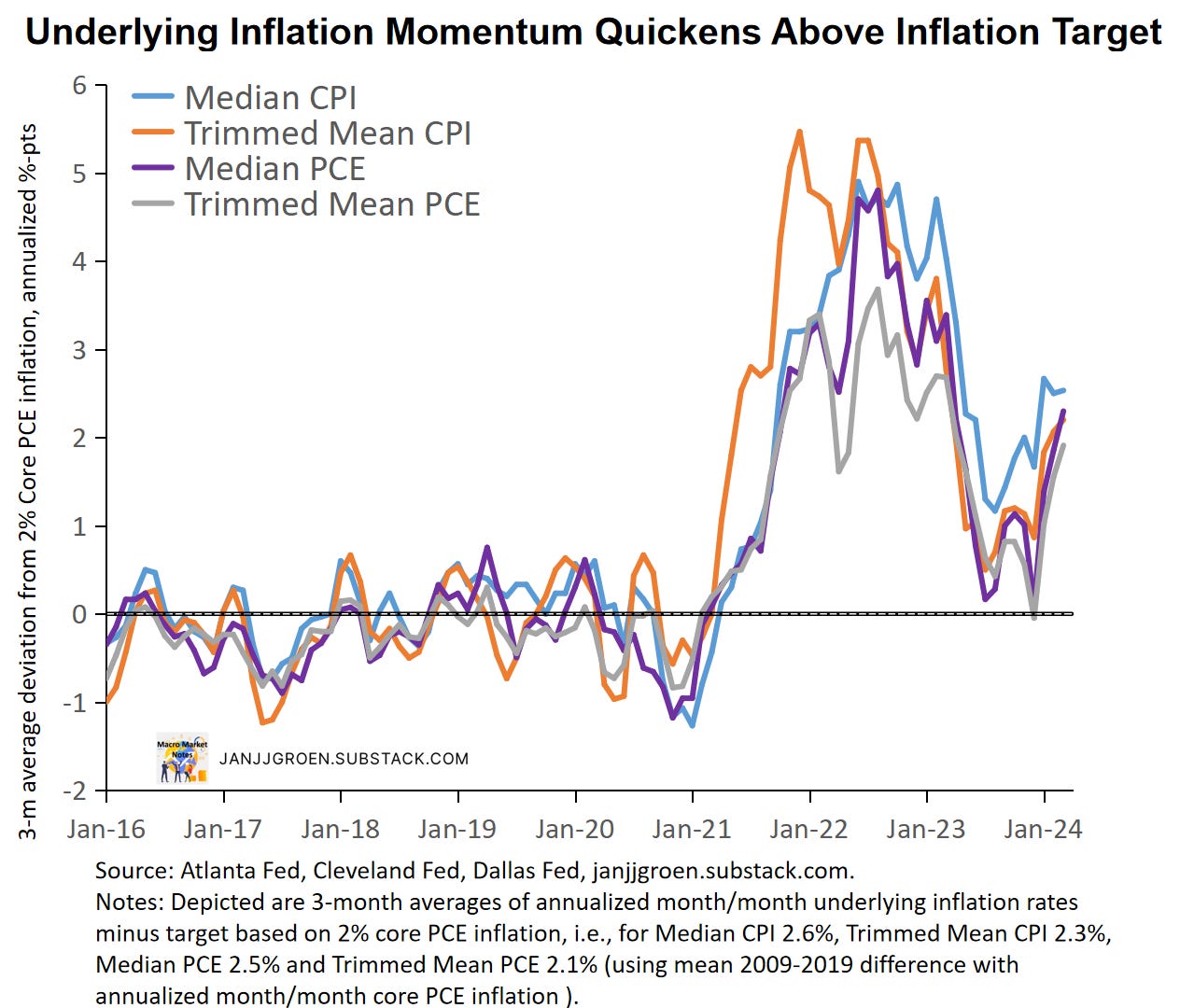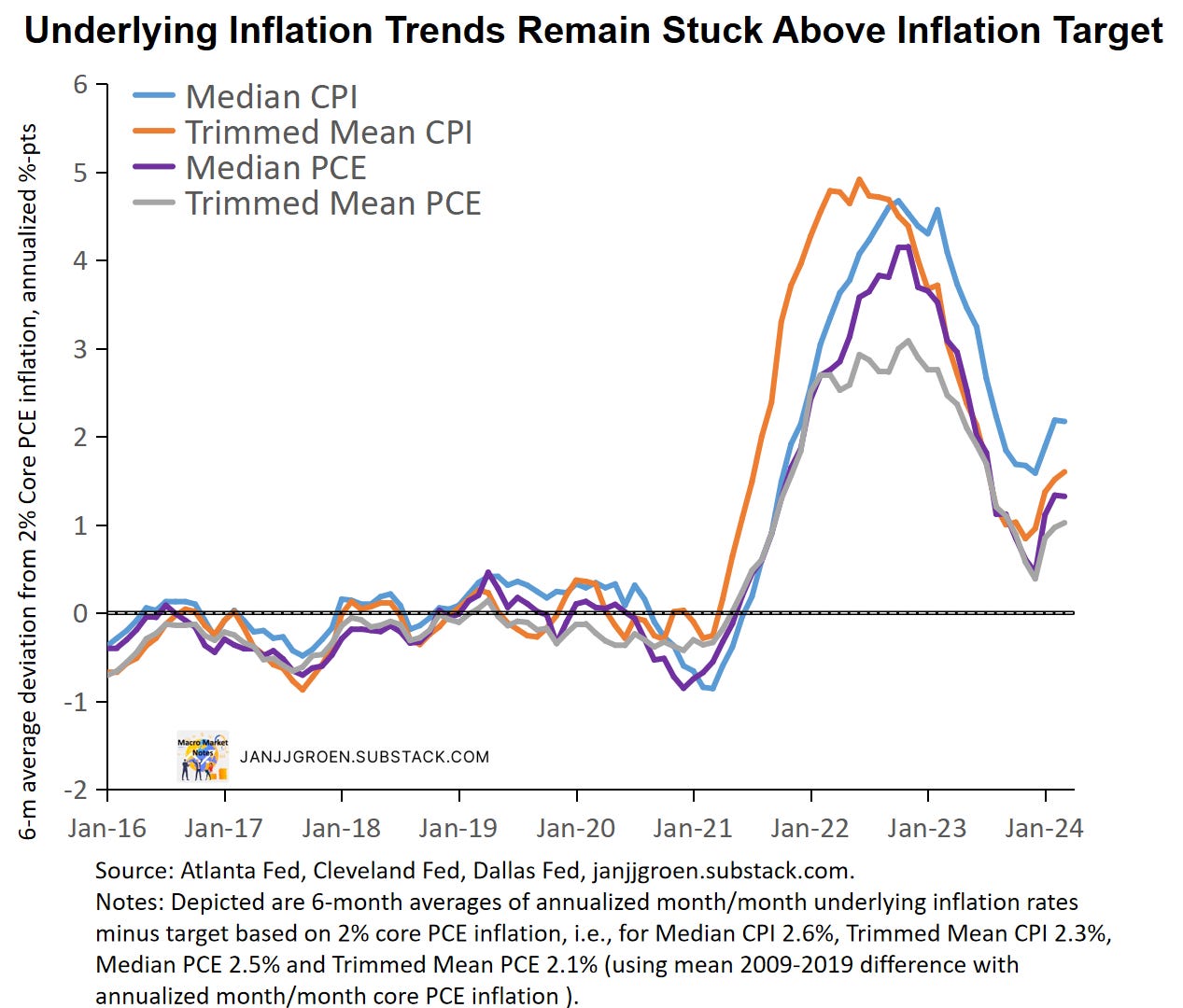March Personal Income & Outlays: Upward Momentum
Growth of personal wage income and underlying real spending picked up again in March. Core services and central tendency inflation rates accelerated.
The March Personal Income and Outlays report provides a good insight on the U.S. consumer as well as inflationary pressures going forward. This note presents some of these insights.
Key takeaways:
Personal income growth out of wages and salaries increased in March and remains stuck above the growth rate that is consistent with 2% PCE inflation over the medium-term.
The stock of excess savings has NOT run out and continues to be a tailwind for consumption. Between February and March, it fell around $39 billion and equaled about $571 billion in March.
Real PCE growth accelerated, but the underlying (trimmed mean) growth rate ran at an even faster pace than the headline rate in March. This suggests that consumption growth will remain robust in H1 2024 and could pick up the pace in Q2.
Core services excl. housing PCE inflation, the Fed’s favorite gauge of underlying inflation, remains at elevated levels with accelerating momentum. More boarder based underlying inflation measures accelerated since late 2023 further above the Fed’s inflation target. The central tendency of PCE inflation currently sits about 1 percentage point above the Fed’s inflation target.
With upward momentum in real spending, solid growth rates of wage income and spending as well as elevated non-housing core services and underlying inflation rates, the Fed is unlikely to cut rates this summer.
Wage Income Growth Increased
A dominant source of household income is personal income out of wages and salaries. Today’s report showed essentially no revisions in the recent growth of household income out of wages and salaries throughout Q1 2024.
The year/year growth rate in March increased compared to February (chart above), as it went up to 5.5% from 5.4% (broadly unrevised). Note that overall personal income growth remained broadly unchanged at 4.7% year/year, implying that growth of non-wage income (interest and dividend income as well as government transfers) took a step back in March albeit less so than in February.
To interpret wage income growth trends, I earlier proposed to compare wage income growth with a neutral benchmark growth rate based on trend non-farm business sector (NFB) output growth and either the abovementioned common inflation expectations factor or the 2% Fed inflation target. Similar to what I did when discussing wages and inflation expectations in my October update, I now also incorporate trend labor share growth into this neutral benchmark.
Any deviation in actual household wage income growth above or below the aforementioned the inflation target-consistent neutral benchmark means household wage income growth outpaces or cannot sustain in the medium term the 2% inflation target.
The chart above shows that the wage income growth gap based on the Fed’s inflation target remains stuck at about +1 percentage point. Hence, nominal wage income growth continues to run at a pace that remains too high to be able to bring inflation back to target in the medium term.
Earlier I showed that the common trend across near-term inflation expectations of firms and households has eased towards the end of 2023 and currently sits at a year/year PCE inflation equivalent rate of about 2.7%. Given the gap between personal income out of wages and the medium-term benchmark consistent with 2% inflation, the personal wage income growth pace seems more in line with the medium-run pace that would be consistent with this 2.7% inflation expectation rate. Elevated wage income growth therefore remains an upside risk to the medium-term inflation outlook.
With household income growth out of wages and salaries still running above the pace consistent with 2% PCE inflation this might be a sign that households’ incomes are likely to remain strong enough to keep consumption spending elevated.
Pace of Excess Savings Drawdowns Remains Gradual
Household spending was up 0.8% over the month in March, a higher pace compared to disposable household income growth of 0.5% for the same period. As a consequence, the savings rate declined from 3.6% in February (broadly unrevised) to 3.2% in March.
The chart above shows that the savings rate remains below my trend savings rate estimate of 5.2% (down from an unrevised 5.4% in February) using the ‘average of trend’ approach outlined in my earlier excess savings note (orange line). The actual savings rate had been diverging to the downside relative to this trend savings rate estimate since May 2023, but a lot less so compared to trend savings rate assumptions used elsewhere (grey and yellow lines).
Given the earlier discussed (minimal) revisions to personal wage income growth and the decline in my estimate of the trend savings rate, in March cumulative excess savings declined from $610 billion in the previous month to about $571 billion (see chart above).
Note that also in the chart above that interest payments have now become a source of excess savings drawdowns in addition to consumption spending. Hence, going forward with high interest rates increasingly impacting household budgets we can expect a somewhat faster pace of excess savings declines. Nonetheless, above-trend growth in disposable income continues to be a partial offset the drawdowns in excess savings coming from above-trend growth in consumption spending and interest payments.
Trend Pace in Consumption Spending Moved Higher
Strong income growth out of wages in 2023 allowed households to keep spending at a robust pace without the need to completely run down the stock of excess savings. With wage income growth remaining above inflation target pace, this could mean that real consumption expenditures can be expected to remain relatively high for the near term.
As is the case with headline inflation, headline real consumption spending growth often is driven by volatile components that not always reflect the underlying strength of the economy. A core real consumption spending growth measure, therefore, would be really useful, and I do that by approximating such a core measure based on constructing a weighted trimmed mean across 177 components1 of headline real personal consumption expenditures (PCE). This trimmed mean measure provides a more accurate reading on the underlying strength of the economy than headline real PCE growth rates, with the trimmed mean measure decreasing ahead of headline growth before the onset of a recession.
When we focus on the most recent period as in the chart above, the six-month annualized headline real PCE growth was basically in line with the trimmed mean six-month growth rate throughout 2022. That changed in 2023 trimmed mean real PCE growth outpacing headline growth, with the six-month annualized growth rate of trimmed mean real PCE outpacing that of headline PCE growing for most of 2023.
In February, however, the headline and trimmed mean growth rates essentially were identical (based on the March vintage of data), which in itself suggested that going into Q2 2024 we could expect real consumption spending to slow down. However, as the chart above shows, in March the 6-month trimmed mean real consumption growth rate increased substantially, outpacing the increase in the headline real consumption growth rate. This suggests upward momentum for real PCE going into Q2, which could potentially accelerate compared to the 2.5% annualized quarter/quarter increase seen for Q1.
Underlying Inflationary Pressures Remain Too High
In terms of inflation, core PCE inflation quickened in March to a 3.9% annualized monthly rate from an essentially unchanged 3.2% rate in February. Core goods inflation decelerated to 0.8% annualized month/month from 3.8% in February, whereas core service inflation jumped up to 4.9% annualized month/month in March from 3% in the preceding month.
The Fed’s favorite gauge of underlying inflation, core services excl. housing PCE inflation was the main driver behind the March core service inflation acceleration, as its pace was pushed up from (an upwardly revised) 2.3% annualized month/month to about 4.8%. Given the large volatility in this measure since late 2023 it seems worthwhile to smooth through noisy month-over-month dynamics.
The chart above plots three-, six- and 12-month annualized inflation rates for the non-housing core services PCE deflator. The average annualized monthly rate still reads about 4% for the post-COVID era (black dashed line), two times the average rate we observed for the immediate years pre-COVID.
The momentum measures in the chart above have been sticky around 4% for most of 2023. But in Q4 2023 momentum in core services excl. housing PCE inflation appeared to ease in a tentative sign that it might finally start to break free from the post-pandemic 4% trend. However, since the end of 2023 this disinflationary trend reversed, and this became even more evident in March.
Instead of focusing on whether specific components of inflation should be ignored or not when assessing underlying inflation trends, one could focus on the central tendency of consumer price inflation, a.k.a. the center of the distribution of all price changes unaffected by extremely volatile consumer price components. This could potentially provide a better sense of the target toward which inflation moves over time once those excessively volatile price changes have stabilized.
The Cleveland and Dallas Federal Reserve Banks construct such measures of central tendency for the CPI and PCE price indices using a variety of trimming procedures to weed out excessive volatile components of these price indices in a given month:
Median CPI (Cleveland Fed), which takes the inflation rate of the component at the 50% percentile of the CPI component price changes.
Trimmed Mean CPI (Cleveland Fed), where the highest 8% and lowest 8% of CPI component price changes are dropped.
Median PCE (Cleveland Fed), which takes the inflation rate of the component at the 50% percentile of the PCE component price changes.
Trimmed Mean PCE (Dallas Fed), where the highest 31% and lowest 24% of PCE component price changes are dropped.
The chart above scales each of these measures into a three-month average distance relative to 2% core PCE inflation as a measure of the Fed's inflation target. A lot of progress was made in H2 2023 in terms of a slowing in the central tendency of U.S. inflation back towards that 2% target. That all changed towards the end of last year and since then underlying three-month inflation rates increased their overshoot of the Fed's inflation target.
Alternatively, it might be more insightful to look at the smoother six-month averages of the annualized percentage point deviation of monthly central tendency inflation measures relative to their values as implied by 2% core PCE inflation. The chart above suggests a similar story as for the three-month average measures: a lot of progress was made in 2023 in terms of return back towards the Fed’s 2% inflation target, which since late 2023 reversed.
The six-month average deviations of underlying PCE inflation rates relative to the inflation target in the chart above suggest that currently the underlying PCE inflation trend sits at around 3%. And with even more elevated underlying inflation rates on a three-month average basis, this is not likely to have slowed meaningfully by the summer.
With households’ wage income growth in-line with above-target PCE inflation over the medium term and a strong labor market, conditions continue to be in place that hampers disinflation in the core services sector. A higher pace of underlying real spending growth suggests consumption might not help the disinflation process either. And with underlying inflation trends likely to remain more in line with 3% core PCE inflation than 2% at least into Q2, Fed funds rate cuts are unlikely to happen by this summer.
For a description of these 177 components, see Appendix A in the Dallas Fed trimmed mean PCE inflation working paper.




